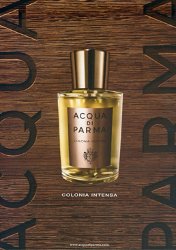
Acqua di Parma Colonia Intensa is not a stronger, longer-lasting version of Acqua di Parma Colonia; Colonia Intensa is a brand-new fragrance. Colonia Intensa’s opening reminds me of Christian Dior Eau Sauvage, its mid-development recalls Annick Goutal Eau du Sud and its finish resembles Monsieur Balmain’s base notes. With such great precursors (and delicious-smelling ingredients), I found Colonia Intensa hard to resist…



